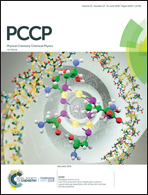A new electrochemical cell with a uniformly accessible electrode to study fast catalytic reactions
Abstract
The electrochemical study of fast catalytic reactions is limited by mass transport when using the conventional electrochemical cell with a rotating disk electrode (RDE). To overcome this issue, it is important to find a new device with improved transport properties that respects electrochemical constraints. We used numerical simulations of computational fluid dynamics to design a new electrochemical cell based on the so-called “jet flow” design for the kinetic studies of catalytic chemical reactions at the surface of an electrode. The new cell is characterized by a high, reliable and uniform mass transport over the electroactive part of its surface. We investigated the effects of the nozzle and the electrode diameters, the nozzle–electrode distance and the Reynolds number on the performance of the jet-electrode in the flow system. Through the optimization of the geometry of this jet electrode cell, we achieved a factor of 3 enhancement in transport compared to the rotating disk electrode. We succeeded in constructing the designed electrode, characterized it with electrochemical techniques, and found an excellent agreement between the transport properties deduced from the numerical simulations and those from the measurements.



 Please wait while we load your content...
Please wait while we load your content...